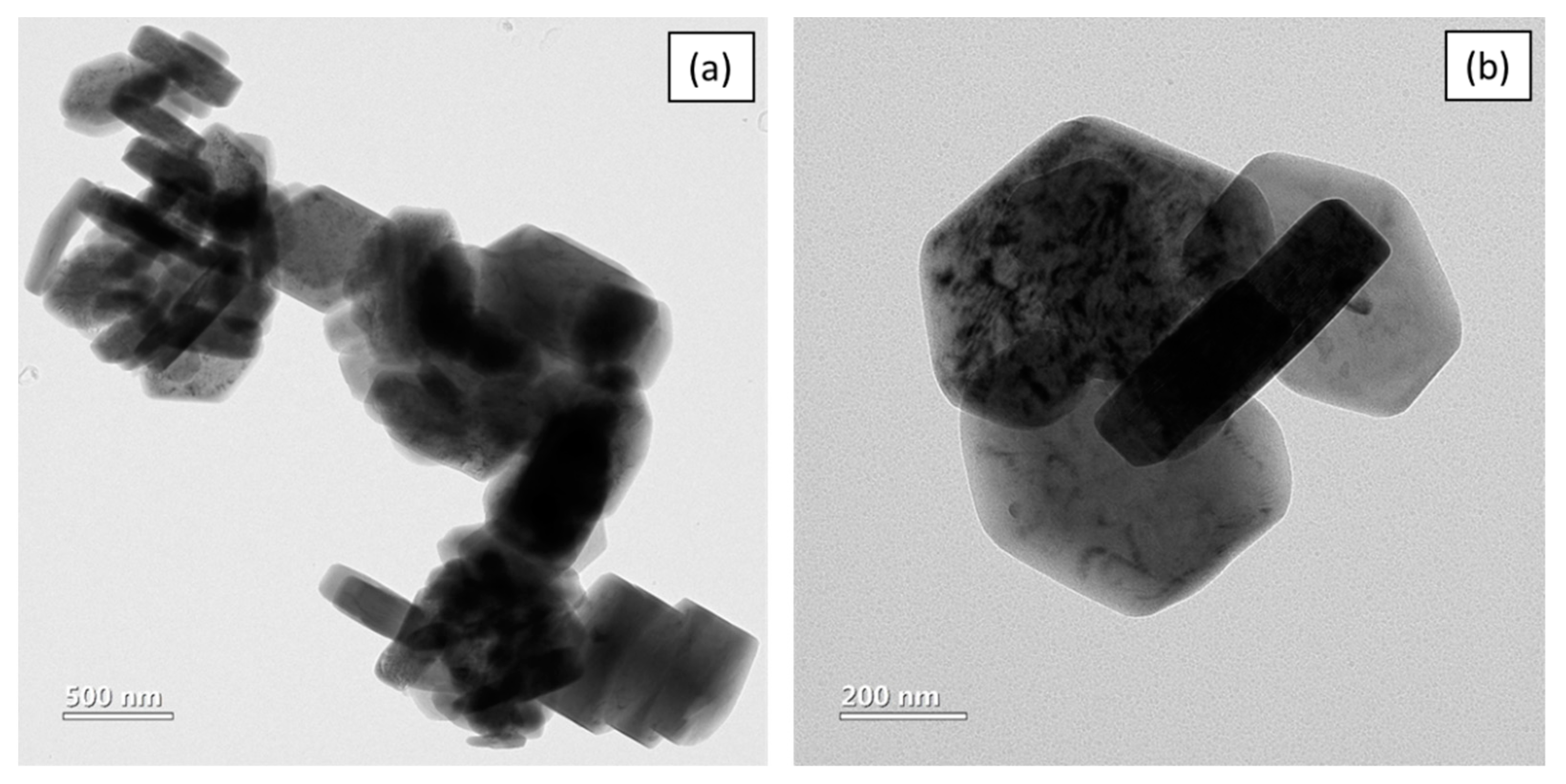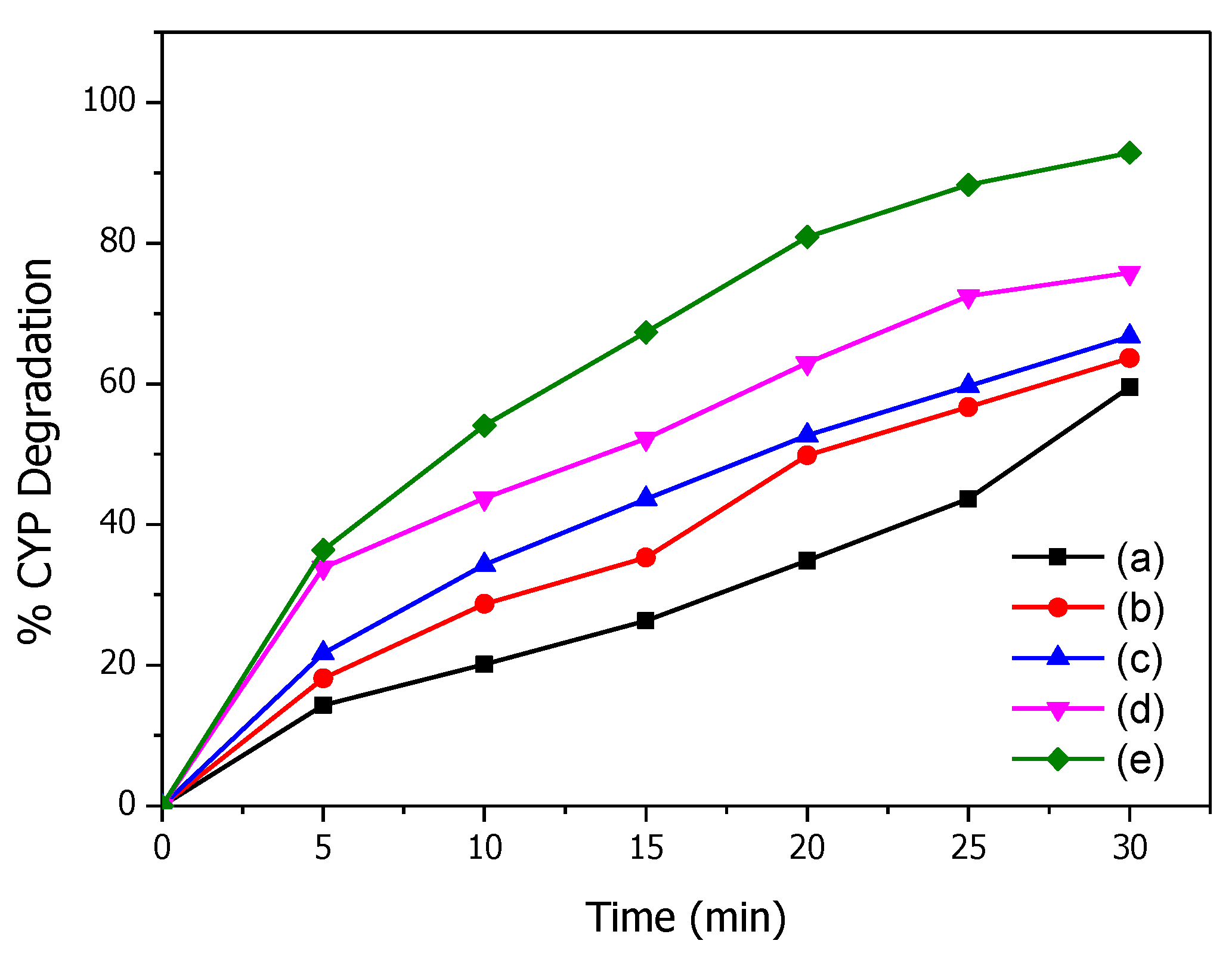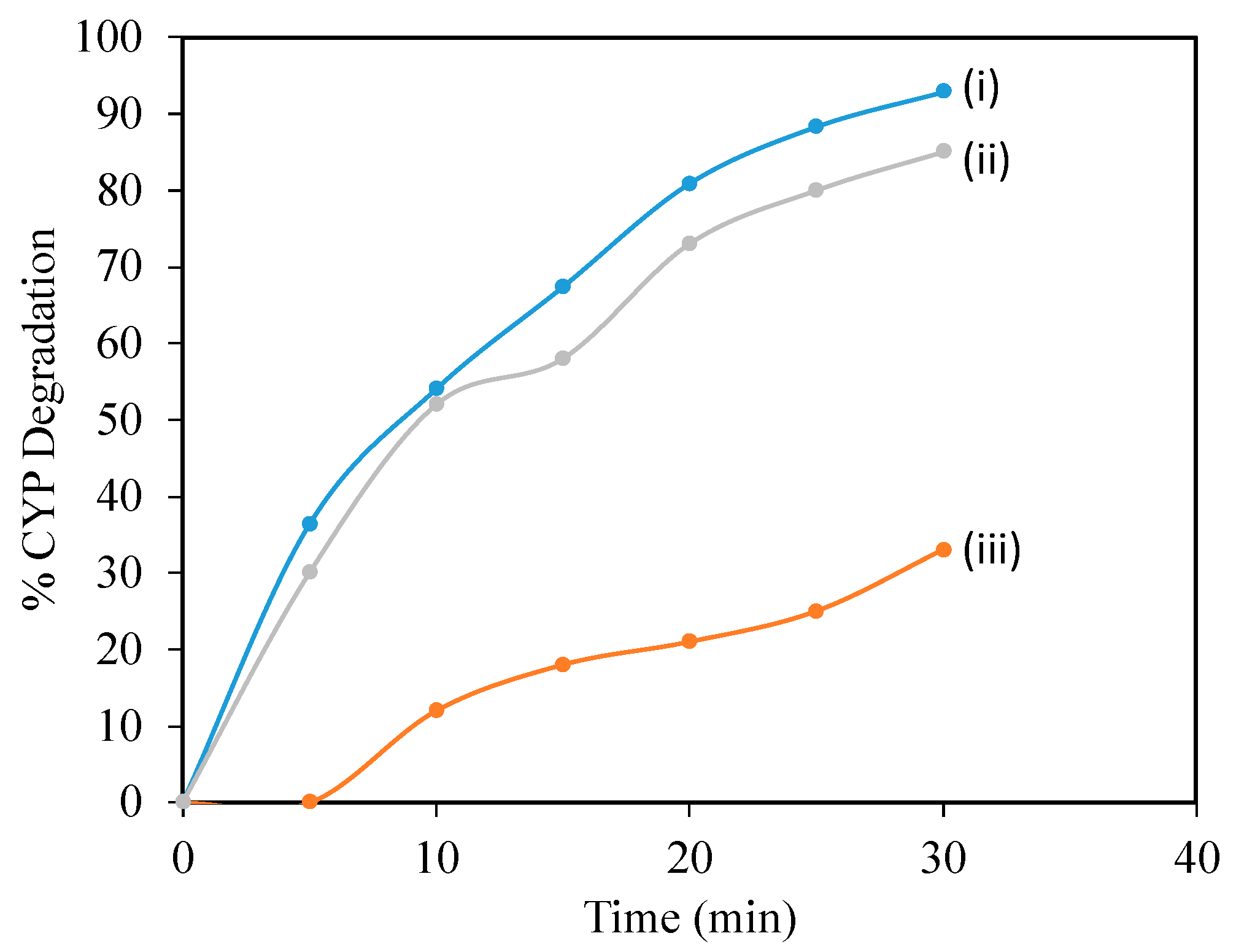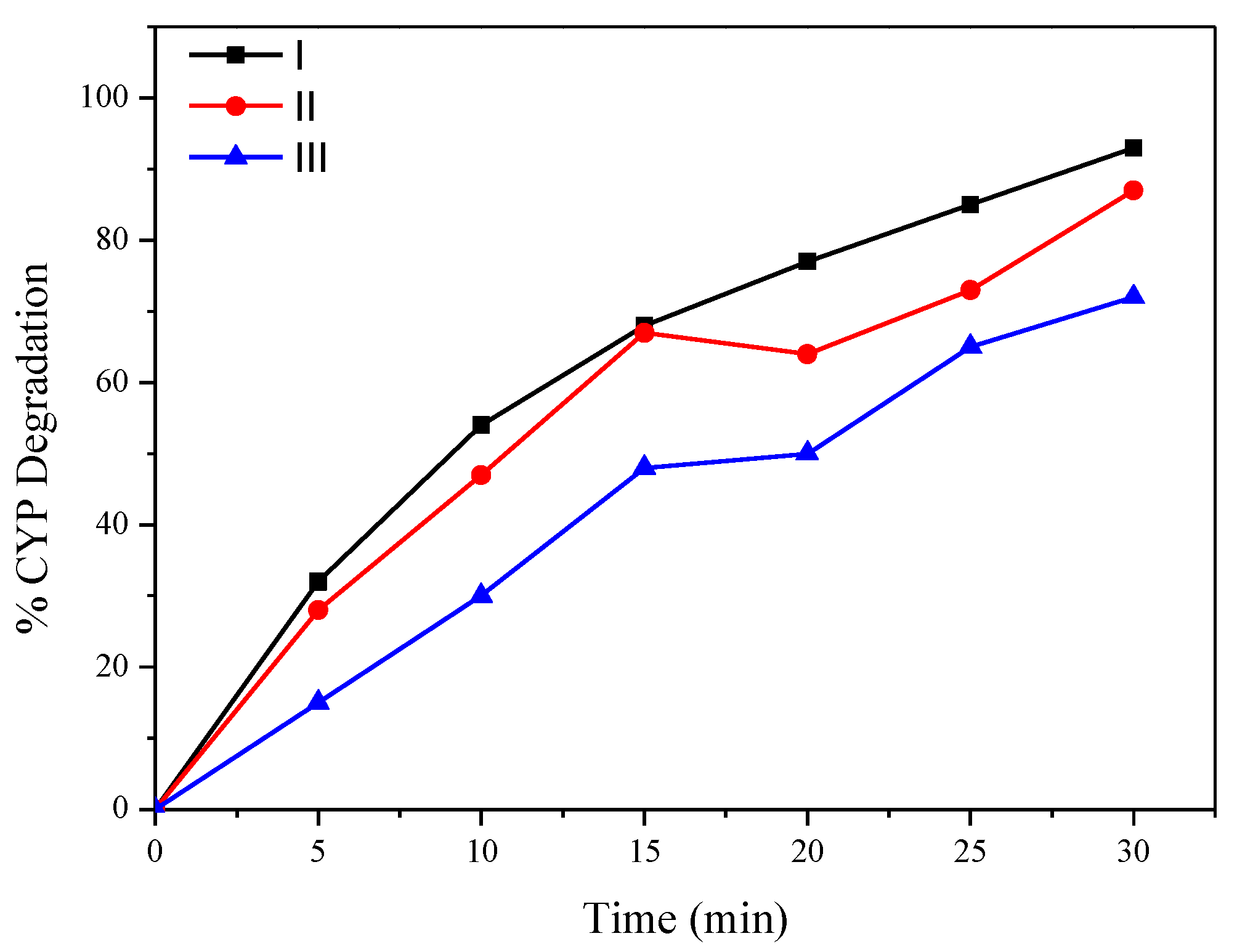Investigation of the Degradation Behavior of Cyclophosphamide by Catalytic Ozonation Based on Mg(OH)2
Abstract
:1. Introduction
2. Materials and Methods
2.1. Material Characterization
2.2. Experimental Section
2.2.1. Effect of Catalyst Dosage
2.2.2. Estimation of OH· by Mg (OH)2/O3
2.2.3. Reusability of Mg (OH)2 for Catalytic Ozonation
2.2.4. Analytical Methods
2.2.5. Total Organic Carbon (TOC)
2.2.6. Catalytic Degradation of CYP in Synthetic Effluent
3. Results and Discussion
4. Conclusions
Author Contributions
Funding
Institutional Review Board Statement
Informed Consent Statement
Data Availability Statement
Conflicts of Interest
References
- Yang, L.; Hu, C.; Nie, Y.; Qu, J. Catalytic ozonation of selected pharmaceuticals over mesoporous alumina-supported manganese oxide. Environ. Sci. Technol. 2009, 43, 2525–2529. [Google Scholar] [CrossRef] [PubMed]
- Von Gunten, U.; Salhi, E.; Schmidt, C.K.; Arnold, W.A. Kinetics and mechanisms of N-nitrosodimethylamine formation upon ozonation of N, N-dimethylsulfamide-containing waters: Bromide catalysis. Environ. Sci. Technol. 2010, 44, 5762–5768. [Google Scholar] [CrossRef] [PubMed]
- Yang, W.; Bunian, M.; Chen, X.; Heald, S.; Yu, L.; Wen, J.; Lei, Y.; Wu, T. Plasmon-enhanced Catalytic Ozonation for Efficient Removal of Recalcitrant Water Pollutants. ACS EST Eng. 2021, 1, 874–883. [Google Scholar] [CrossRef]
- Huber, M.M.; Canonica, S.; Park, G.Y.; Von Gunten, U. Oxidation of pharmaceuticals during ozonation and advanced oxidation processes. Environ. Sci. Technol. 2003, 37, 1016–1024. [Google Scholar] [CrossRef] [PubMed]
- Kim, J.; Zhang, T.; Liu, W.; Du, P.; Dobson, J.T.; Huang, C.H. Advanced Oxidation Process with Peracetic Acid and Fe (II) for Contaminant Degradation. Environ. Sci. Technol. 2019, 53, 13312–13322. [Google Scholar] [CrossRef]
- Tran, V.A.; Nguyen, T.P.; Le, V.T.; Kim, I.T.; Lee, S.-W.; Nguyen, C.T. Excellent photocatalytic activity of ternary Ag@WO3@rGO nanocomposites under solar simulation irradiation. J. Sci. Adv. Mater. Devices 2021, 6, 108–117. [Google Scholar] [CrossRef]
- Nguyen, V.-H.; Thi Vo, T.-T.; Huu Do, H.; Thuan Le, V.; Nguyen, T.D.; Ky Vo, T.; Nguyen, B.-S.; Nguyen, T.T.; Phung, T.K.; Tran, V.A. Ag@ZnO porous nanoparticle wrapped by rGO for the effective CO2 electrochemical reduction. Chem. Eng. Sci. 2021, 232, 116381. [Google Scholar] [CrossRef]
- Hieu, V.Q.; Lam, T.C.; Khan, A.; Thi Vo, T.-T.; Nguyen, T.-Q.; Doan, V.D.; Tran, D.L.; Le, V.T.; Tran, V.A. TiO2/Ti3C2/g-C3N4 ternary heterojunction for photocatalytic hydrogen evolution. Chemosphere 2021, 285, 131429. [Google Scholar] [CrossRef]
- Anh Tran, V.; Khoa Phung, T.; Thuan Le, V.; Ky Vo, T.; Tai Nguyen, T.; Anh Nga Nguyen, T.; Quoc Viet, D.; Quang Hieu, V.; Thi Vo, T.-T. Solar-light-driven photocatalytic degradation of methyl orange dye over Co3O4-ZnO nanoparticles. Mater. Lett. 2021, 284, 128902. [Google Scholar] [CrossRef]
- Gadipelly, C.; Pérez-González, A.; Yadav, G.D.; Ortiz, I.; Ibáñez, R.; Rathod, V.K.; Marathe, K.V. Pharmaceutical industry wastewater: Review of the technologies for water treatment and reuse. Ind. Eng. Chem. Res. 2014, 53, 11571–11592. [Google Scholar] [CrossRef]
- von Gunten, U. Oxidation Processes in Water Treatment: Are We on Track? Environ. Sci. Technol. 2018, 52, 5062–5075. [Google Scholar] [CrossRef] [PubMed]
- Patel, M.; Kumar, R.; Kishor, K.; Mlsna, T.; Pittman, C.U.; Mohan, D. Pharmaceuticals of emerging concern in aquatic systems: Chemistry, occurrence, effects, and removal methods. Chem. Rev. 2019, 119, 3510–3673. [Google Scholar] [CrossRef] [PubMed] [Green Version]
- Yu, G.; Wang, Y.; Cao, H.; Zhao, H.; Xie, Y. Reactive Oxygen Species and Catalytic Active Sites in Heterogeneous Catalytic Ozonation for Water Purification. Environ. Sci. Technol. 2020, 54, 5931–5946. [Google Scholar] [CrossRef] [PubMed]
- Von Gunten, U. Ozonation of drinking water: Part I. Oxidation kinetics and product formation. Water Res. 2003, 37, 1443–1467. [Google Scholar] [CrossRef]
- Hermes, N.; Jewell, K.S.; Falås, P.; Lutze, H.V.; Wick, A.; Ternes, T.A. Ozonation of Sitagliptin: Removal Kinetics and Elucidation of Oxidative Transformation Products. Environ. Sci. Technol. 2020, 54, 10588–10598. [Google Scholar] [CrossRef]
- Kasprzyk-Hordern, B.; Ziółek, M.; Nawrocki, J. Catalytic ozonation and methods of enhancing molecular ozone reactions in water treatment. Appl. Catal. B Environ. 2003, 46, 639–669. [Google Scholar] [CrossRef]
- Lee, J.Y.; Lee, Y.M.; Kim, T.K.; Choi, K.; Zoh, K.D. Degradation of cyclophosphamide during UV/chlorine reaction: Kinetics, byproducts, and their toxicity. Chemosphere 2021, 268, 128817. [Google Scholar] [CrossRef]
- Emídio, E.S.; Hammer, P.; Nogueira, R.F.P. Simultaneous degradation of the anticancer drugs 5-fluorouracil and cyclophosphamide using a heterogeneous photo-Fenton process based on copper-containing magnetites (Fe3−xCuxO4). Chemosphere 2020, 241, 124990. [Google Scholar] [CrossRef]
- Steger-Hartmann, T.; Kümmerer, K.; Hartmann, A. Biological Degradation of Cyclophosphamide and Its Occurrence in Sewage Water. Ecotoxicol. Environ. Saf. 1997, 36, 174–179. [Google Scholar] [CrossRef]
- Lancharro, P.M.; De Castro-Acuña Iglesias, N.; González-Barcala, F.J.; González, J.D.M. Evidence of exposure to cytostatic drugs in healthcare staff: A review of recent literature. Farm. Hosp. 2016, 40, 604–621. [Google Scholar]
- Wishart, D.S.; Feunang, Y.D.; Marcu, A.; Guo, A.C.; Liang, K.; Vázquez-Fresno, R.; Sajed, T.; Johnson, D.; Li, C.; Karu, N.; et al. HMDB 4.0: The human metabolome database for 2018. Nucleic Acids Res. 2018, 46, D608–D617. [Google Scholar] [CrossRef] [PubMed]
- Osawa, R.A.; Barrocas, B.T.; Monteiro, O.C.; Oliveira, M.C.; Florêncio, M.H. Photocatalytic degradation of cyclophosphamide and ifosfamide: Effects of wastewater matrix, transformation products and in silico toxicity prediction. Sci. Total Environ. 2019, 692, 503–510. [Google Scholar] [CrossRef]
- Česen, M.; Kosjek, T.; Busetti, F.; Kompare, B.; Heath, E. Human metabolites and transformation products of cyclophosphamide and ifosfamide: Analysis, occurrence and formation during abiotic treatments. Environ. Sci. Pollut. Res. 2016, 23, 11209–11223. [Google Scholar] [CrossRef] [PubMed]
- Sánchez-Polo, M.; Rivera-Utrilla, J.; Zaror, C.A. Advanced oxidation with ozone of 1,3,6-naphthalenetrisulfonic acid in aqueous solution. J. Chem. Technol. Biotechnol. 2002, 77, 148–154. [Google Scholar] [CrossRef]
- Chen, J.; Tian, S.; Lu, J.; Xiong, Y. Catalytic performance of MgO with different exposed crystal facets towards the ozonation of 4-chlorophenol. Appl. Catal. A Gen. 2015, 506, 118–125. [Google Scholar] [CrossRef]
- Wang, B.; Xiong, X.; Ren, H.; Huang, Z. Preparation of MgO nanocrystals and catalytic mechanism on phenol ozonation. RSC Adv. 2017, 7, 43464–43473. [Google Scholar] [CrossRef] [Green Version]







| Component | mg/L |
|---|---|
| Sucrose | 50 |
| Urea | 20 |
| Citric acid | 20 |
| Humic acid | 20 |
| Sodium dodecyl sulfate | 10 |
| Ammonium phosphate | 30 |
| Ammonium chloride | 30 |
| Sodium sulfate | 20 |
| Sodium chloride | 70 |
| Sodium carbonate | 20 |
| Calcium nitrate | 20 |
| Magnesium chloride | 20 |
| Potassium nitrate | 20 |
| MnSO4·5H2O | 3.0 |
| FeCl3·3H2O | 0.2 |
Publisher’s Note: MDPI stays neutral with regard to jurisdictional claims in published maps and institutional affiliations. |
© 2022 by the authors. Licensee MDPI, Basel, Switzerland. This article is an open access article distributed under the terms and conditions of the Creative Commons Attribution (CC BY) license (https://creativecommons.org/licenses/by/4.0/).
Share and Cite
Prasanna.V, L.; Avisar, D. Investigation of the Degradation Behavior of Cyclophosphamide by Catalytic Ozonation Based on Mg(OH)2. Energies 2022, 15, 2274. https://doi.org/10.3390/en15062274
Prasanna.V L, Avisar D. Investigation of the Degradation Behavior of Cyclophosphamide by Catalytic Ozonation Based on Mg(OH)2. Energies. 2022; 15(6):2274. https://doi.org/10.3390/en15062274
Chicago/Turabian StylePrasanna.V, Lakshmi, and Dror Avisar. 2022. "Investigation of the Degradation Behavior of Cyclophosphamide by Catalytic Ozonation Based on Mg(OH)2" Energies 15, no. 6: 2274. https://doi.org/10.3390/en15062274






